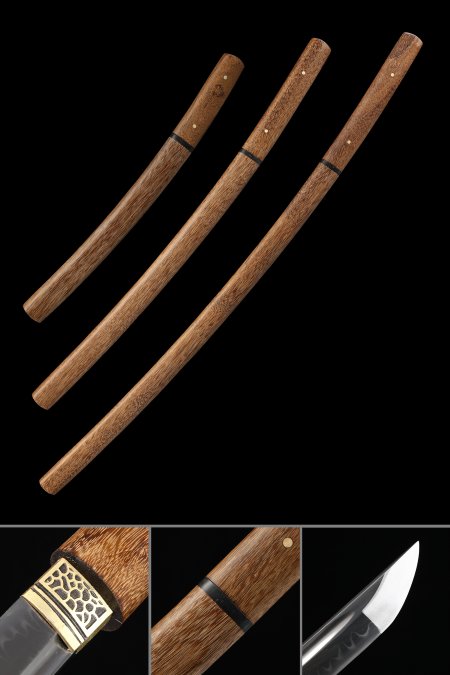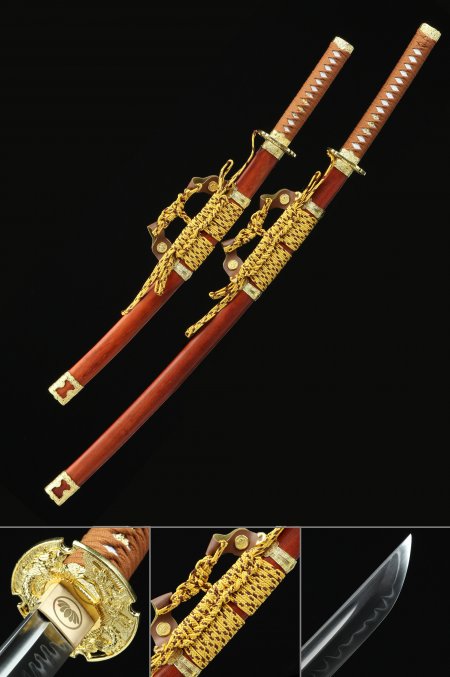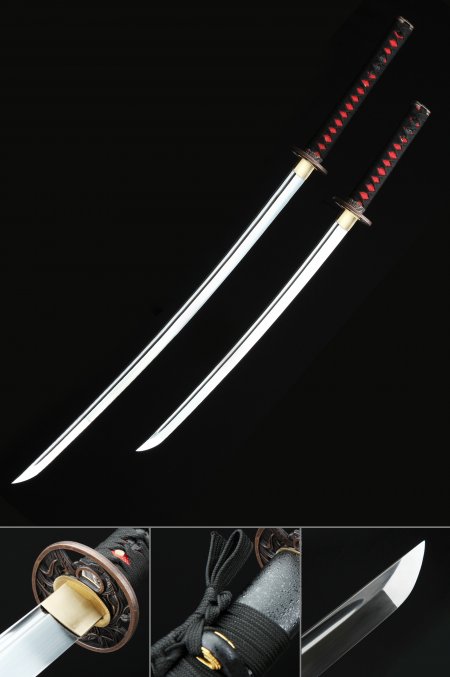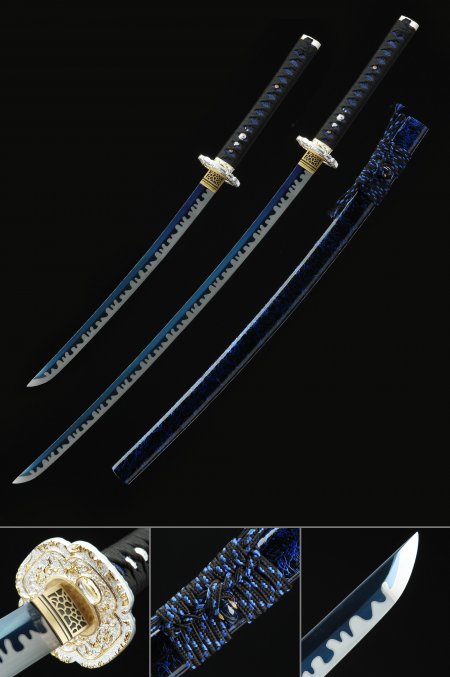Elevate your collection with the Daisho Set, a stunning pair of katana and wakizashi that embody the true spirit of the samurai. Perfect for both novice and seasoned sword enthusiasts, this set showcases impeccable craftsmanship, with razor-sharp blades and perfectly balanced designs. The Daisho Set offers an authentic and captivating experience, whether for display or practice. Embrace the tradition and artistry of the samurai with this extraordinary duo, capturing the essence of honor and skill. Make the Daisho Set the centerpiece of your collection and experience the unparalleled elegance and power of these legendary blades.




I'm verry happy with the daisho set, it is beautiful, nice , and sharp :)
 |
Daisho Set, Japanese Katana And Wakizashi Sword Set High Manganese Steel |
My Daisho set is beautiful and very well made. I also purchased the matching tango and a stand for display. The team a TrueKatana are very helpful, friendly, and willing to assist you.
 |
Daisho Set, Japanese Katana And Wakizashi Sword Set High Manganese Steel |
The swords are beautifully designed, crafted with attention to detail, and combine form with function. Shipping was very quick (9 days), and packed appropriately for distance and handling. The Hamon of the blades reflect the years of art and service to the legacy of the warrior. I am impressed.
 |
Real Hamon Japanese Daisho Set Shirasaya Katana, Wakizashi And Tanto Sword Without Tsuba 3 Set |
I bought this set as an anniversary gift to my husband and he LOVES them. Shipping took a bit longer than expected so it came a few days after our anniversary but he is so happy with how they look.
 |
Daisho Set, Japanese Katana And Wakizashi Sword Set High Manganese Steel |
Very impressed. Sharp blades, fine craftsmanship and your efficiency from placing the order to delivery was impeccable. Arrived earlier than estimated. I look forward to doing future business with you
 |
Real Hamon Japanese Daisho Set Shirasaya Katana, Wakizashi And Tanto Sword Without Tsuba 3 Set |
The Japanese Daisho Set appears to be very nice aesthetically. Will make a nice display set.
 |
Real Hamon Japanese Daisho Set Shirasaya Katana, Wakizashi And Tanto Sword Without Tsuba 3 Set |
Really happy with this set. Purchased for kendo kata (mainly demonstrations etc.), and they certainly fit the bill! The fittings are solid and the handling is excellent. An excellent choice for kata!
 |
Daisho Set, Japanese Katana And Wakizashi Sword Set High Manganese Steel |
Fast, secure and well protected shipping! No problems at all! Quality products all the way around! Fit and finish is Excellent! Mirror like polish and super sharp! Pictures do not do justice to these beauties! Most pleased with transaction! Will buy from TRUEKATANA again! Future business earned!
 |
Daisho Set, Japanese Katana And Wakizashi Sword Set High Manganese Steel |
shipped and arrived on time and very well packaged. no damage and blades were sharp and greased and wrapped in plastic film.
scabbards are beautiful and well-constructed. of the three the tanto, small blade was tight in the scabbard, but a little bit of file work corrected that issue and I put a very little bit of grease on the inside and worked the blade in and out to where it is now perfect. I applied furniture wax to the scabbard's and buffed and polished them to a high shine.
highly recommend these blades and they look great on the display stand.
 |
Real Hamon Japanese Daisho Set Shirasaya Katana, Wakizashi And Tanto Sword Without Tsuba 3 Set |
I got everything as advertised and in excellent condition! It even arrived in a very short time for international shipping! Pleasantly surprised by this company and will most likely order again.
 |
Real Hamon Japanese Daisho Set Shirasaya Katana, Wakizashi And Tanto Sword Without Tsuba 3 Set |
I'm a happy collector !!!! This Daisho Set is better quality and workmanship than I ever expected.
Thank you TrueKatana !!!!!
 |
Real Hamon Japanese Daisho Set Shirasaya Katana, Wakizashi And Tanto Sword Without Tsuba 3 Set |
Great purchase, I would only add that it was unclear if you were using USPS or someone else like UPS. This would be a problem for me since the USPS doesn't deliver to address per my request. (They would deliver to my P.O.Box) I'm crossing my Katana's and hoping my order is delivered via someone other than USPS.
Great products!
 |
Daisho Set, Japanese Katana And Wakizashi Sword Set High Manganese Steel |
IMHO this is the best store if you look for Japanese sword. It's good for beginners and people with experience. I ordered few pieces, got 2 of them , couldn't be more happy. Thanks guys.
 |
Daisho Set, Japanese Katana And Wakizashi Sword Set High Manganese Steel |
A very nice product for a relatively low price. The most obvious shortcoming of the swords isn't very obvious at all, and that is the rough interior of scabbards. Otherwise, the craftsmanship is clean. Shipment was handled well, and packaging thorough, although the blades were overly oiled and some oil had made it's way to the wood handles. The only annoyance has been repeated emails pestering me for this review.
 |
Real Hamon Japanese Daisho Set Shirasaya Katana, Wakizashi And Tanto Sword Without Tsuba 3 Set |
I’ve handled real Japanese swords before and these are the real deal. They are so beautiful in person. They are nearly 8 millimeters thick at the widest part. They feel very sturdy and strong.
So far I’m very satisfied
 |
Real Hamon Japanese Daisho Set Shirasaya Katana, Wakizashi And Tanto Sword Without Tsuba 3 Set |
overall quality item, the sheath can be better. But definitely worthy for the price tag.
 |
Daisho Set, Japanese Katana And Wakizashi Sword Set High Manganese Steel |
Originally thought this could be a sketchy website but the swords came in 2 weeks like they said and were real steel. They weren't as sharp as I was expecting but I still managed to cut myself lol. They have held up pretty nicely since I got them and they are fun to play with ! though the katana is a bit too long for me, they are still fun to wear and display. Definitely recommend !
 |
Daisho Set, Japanese Katana And Wakizashi Sword Set High Manganese Steel |
I wasn't sure what to expect but was quite pleased with this set. The samegawa is of course fake, but the ito is tightly wrapped and the fittings/koshirae are snug. Like I said, I wasn't expecting much but my expectations were surpassed. Thanks!
 |
Daisho Set, Japanese Katana And Wakizashi Sword Set High Manganese Steel |
They are great swords! Sharp and I like that they are oiled!!! However I thought that it came with the black sword holder as well (like in the image above) so that can be a bit misleading.
 |
Daisho Set, Japanese Katana And Wakizashi Sword Set High Manganese Steel |
Misplaced my order but customer service was very nice and understanding and sent the right one. It is well made and very stylish 9.5/10.
 |
Daisho Set, Japanese Katana And Wakizashi Sword Set High Manganese Steel |